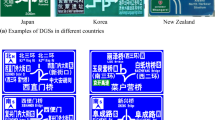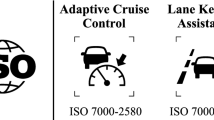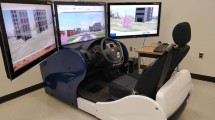Abstract
Many diagrammatic guide signs in China have become much more complex and more difficult to read than those in other countries. Furthermore, there are few regulations or studies regarding diagrammatic guide signs in China. A driving simulator experiment was conducted to analyze the influence of five typical diagrammatic guide signs with different complexities on driving behavior and to evaluate their comprehensive guidance effectiveness via the Technique for Order of Preference by Similarity to Ideal Solution. The rANOVA results indicated that different diagrammatic guide signs have significantly different impacts on driving behavior. A higher complexity of the diagrammatic guide signs negatively impacted the subjective perception, operating status and maneuvering behavior. With increasing diagrammatic guide sign complexity, the gas pedal power significantly decreased at distances of 150–200 m and 50–100 m prior to the signs, the deceleration rapidly increased 150–200 m prior to the signs, the standard deviation of deceleration increased 100–150 m prior to the signs, the standard deviation of speed increased 50–100 m prior to the signs, and the speed decreased and driving time increased 0–50 m prior to the signs. Eight indicators were used to synthetically evaluate the comprehensive guidance effectiveness of the five types of diagrammatic guide signs. The final ranking (from best to worst) of the five diagrammatic guide signs with regard to their effectiveness was obtained. On the whole, a negative correlation relationship exists between the complexity and the comprehensive guidance effectiveness of the five types of diagrammatic guide signs. This relationship should be taken into account when designing new diagrammatic guide signs and optimizing complex diagrammatic guide signs in the future.

















Similar content being viewed by others
Explore related subjects
Discover the latest articles and news from researchers in related subjects, suggested using machine learning.References
Beijing Bureau of Quality and Technical Supervision (2007) Beijing local standard of Road Traffic Signs: Installation Specification for Road Traffic Management Facilities-Part 1: Road Traffic Signs (DB11T493.1-2007)
Beijing Municipal Commission of Transport and Beijing Technology Commission of Traffic Standardization (2016) Beijing technology documents of traffic standardization: Guidelines for Layout of Urban Expressway Direction Signs (BJJT/J 111-2016)
Cafiso S, La Cava G (2009) Driving performance, alignment consistency, and road safety: real-world experiment. Transp Res Rec 2102(1):1–8
Chrysler ST, Williams AA, Funkhouser DS, Holick AJ, Brewer MA (2007) Driver comprehension of diagrammatic freeway guide signs. FHWA/TX-07/0-5147-1. Federal Highway Administration, USA
Cohen J (1988) Statistical power and analysis for the behavioral sciences, 2nd edn. Erlbaum, Hillsdale
Ding H, Zhao X, Rong J (2014) Experimental research on the validation of the driving simulator in Beijing University of Technology. Research report in College of Metropolitan Transportation. Beijing University of Technology
Ding H, Zhao X, Ma J, Rong J (2016a) Evaluation research of the effects of longitudinal speed reduction markings on driving behavior: a driving simulator study. Int J Environ Res Public Health 13(11):1170
Ding L, Shao Z, Zhang H, Xu C, Wu D (2016b) A comprehensive evaluation of urban sustainable development in China based on the TOPSIS-Entropy method. Sustainability 8(8):746
Engström J, Johansson E, Östlund J (2005) Effects of visual and cognitive load in real and simulated motorway driving. Transp Res Part F Traffic Psychol Behav 8(2):97–120
Federal Highway Administration (2009) Manual on uniform traffic control devices for streets and highways. Department of Transportation, USA
Fitzpatrick K, Chrysler ST, Nelson AA, Iragavarapu V (2013) Driving simulator study of signing for complex interchanges. Transportation Research Board 92nd annual meeting
General Administration of Quality Supervision, Inspection and Quarantine of the People’s Republic of China and China National Standardization Management Committee. (2009). National Standards of the People’s Republic of China: road traffic signs and markings-Part 2: road traffic signs (GB5768.2-2009)
Hanscom FR (1971) Evaluation of diagrammatic signing at capital beltway exit, no 1. Report to the Virginia Highway Research Council
Jamson SL, Tate FN, Jamson AH (2005) Evaluating the effects of bilingual traffic signs on driver performance and safety. Ergonomics 48(15):1734–1748
Jiang J, Lu J, Li Y (2010) Setting of road guide signs based on driver’s recognition characteristics. J Southeast Univ (Nat Sci Ed) 40(5):1089–1092
Li X (2011) Research on setting method of traffic guide signs on expressway based on fault-tolerant concept. PhD dissertation, Harbin Institute of Technology
Li Z, Pan W (2010) Econometrics, 3rd edn. Higher Education Press, Beijing
Li Y, Wang J, Zhao X, Rong J (2015) A study on comparison of interchange guide sign standards between China and foreign countries. Road Traffic Saf 15(6):20–27
Li Y, Zhao X, He Q, Huang L, Rong J (2018) Comprehensive evaluation and classification of interchange diagrammatic guide signs’ complexity. J Adv Transp. https://doi.org/10.1155/2018/9865305
Lin C, Lin K, Leung C, Huang CH, Hsu T, Wu C, Chang K, Huang M (2013) Graphic recognition on highway diagrammatic guide sign. In: 5th International congress of international association of societies of design research
Lyu N, Xie L, Wu C, Fu Q, Deng C (2017) Driver’s cognitive workload and driving performance under traffic sign information exposure in complex environments: a case study of the highways in China. Int J Environ Res Public Health 14(2):203
Mast TM, Kolsrud GS (1972) Diagrammatic guide signs for use on controlled access highways, vol 1. Recommendations for diagrammatic guide signs. FHWA-RD-73-21. Federal Highway Administration, United States. Offices of Research and Development
Olson DL (2004) Comparison of weights in TOPSIS models. Math Comput Model 40(7–8):721–727
Qiao F, Liu X, Yu L (2007) Using driving simulator for advance placement of guide sign design for exits along highways. In: Proceedings of the driving simulator conference (DSC) 2007 North America in Iowa City, pp 12–14
Qin Z, Chen G, Li T, Sun W, Fu B (2018) CW-TOPSIS mine internal caused fire evaluation model of “AHP+ entropy weight method”. J Xi’an Univ Sci Technol 2:5
Qin X, Su X, Chen X (2019) Multi-objective optimization of injection moulding scheme for upper cover of automobile intake manifold based on entropy weight method. Plast Sci Technol 03:70–75
Rahman MM, Strawderman L, Garrison T, Eakin D, Williams CC (2017) Work zone sign design for increased driver compliance and worker safety. Acid Anal Prev 106:67–75
Shu W (2004) Design of road signs on urban expressways. J China Foreign Highw 24(4):184–186
Song D (2010) Research on graphic design in urban public traffic logo. Packag Eng 16:94–96, 110
Wang J, Zu Y, Lu J (2017) Research on design method of exit guide signs in urban expressway. J People’s Public Secur Univ Nat Sci Ed 23(1):60–66
Wickens CD (1987) Information processing, decision-making, and cognition. In: Salvendy G (ed) Handbook of human factors. Wiley, New York, pp 72–107
Xu F, He Y, Yu X (2008) Measurement of urban transportation efficiency based on entropy method and fuzzy synthetic evaluation model-taking Nanjing as example. Math Pract Theory 48(23):17–23
Zahabi M, Machado P, Lau MY, Deng Y, Pankok C Jr, Hummer J, Kaber DB (2017) Driver performance and attention allocation in use of logo signs on freeway exit ramps. Appl Ergon 65:70–80
Zhao X (2016) Research on effectiveness evaluation and optimization method of installation of interchange exit guide signs in urban expressway. 2016-kjc-01-002. China. Research Report of Beijing Municipal Commission of Transport
Zhao X, Huang L, Rong J (2015) Influence of the interchange pattern guide sign on running speed in an urban complex interchange. J Beijing Univ Technol 41(9):1405–1414
Zhao N, Zhao X, Lin Z, Song Y (2018) Advance guide sign design considering the guidance demand of indirect reached freeway information. J Beijing Univ Technol 44(08):1129–1135
Zwahlen HT, Schnell T (2000) Evaluation of ground mounted diagrammatic entrance ramp approach signs: final report, October 2000 (No. FHWA/OH-2000/018). Ohio Research Institute for Transportation and the Environment. Human Factors and Ergonomics Laboratory
Zwahlen H, Russ A, Roth J, Schnell T (2003) Effectiveness of ground-mounted diagrammatic advance guide signs for freeway entrance ramps. Transp Res Rec 1843:70–80
Acknowledgements
This study was supported by a project of the Beijing Municipal Commission of Transport: Research on Effectiveness Evaluations and Optimization Methods for the Installation of Interchange Exit Guide Signs on Urban Expressways (2016-kjc-01-002).
Author information
Authors and Affiliations
Corresponding author
Additional information
Publisher's Note
Springer Nature remains neutral with regard to jurisdictional claims in published maps and institutional affiliations.
Rights and permissions
About this article
Cite this article
Huang, L., Zhao, X., Li, Y. et al. Evaluation research of the effects of diagrammatic guide signs with different complexities on driving behavior. Cogn Tech Work 22, 843–860 (2020). https://doi.org/10.1007/s10111-019-00604-0
Received:
Accepted:
Published:
Issue Date:
DOI: https://doi.org/10.1007/s10111-019-00604-0




